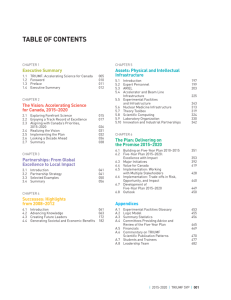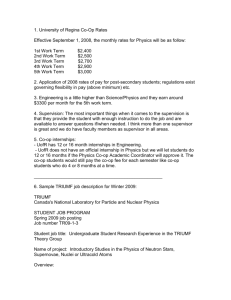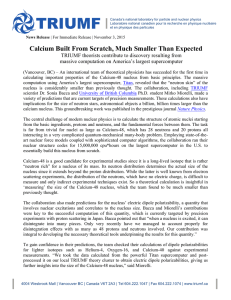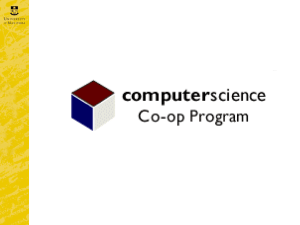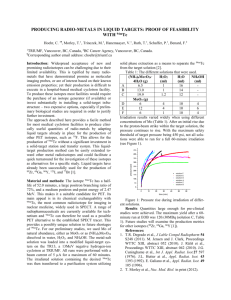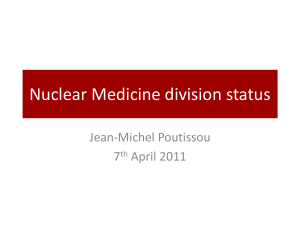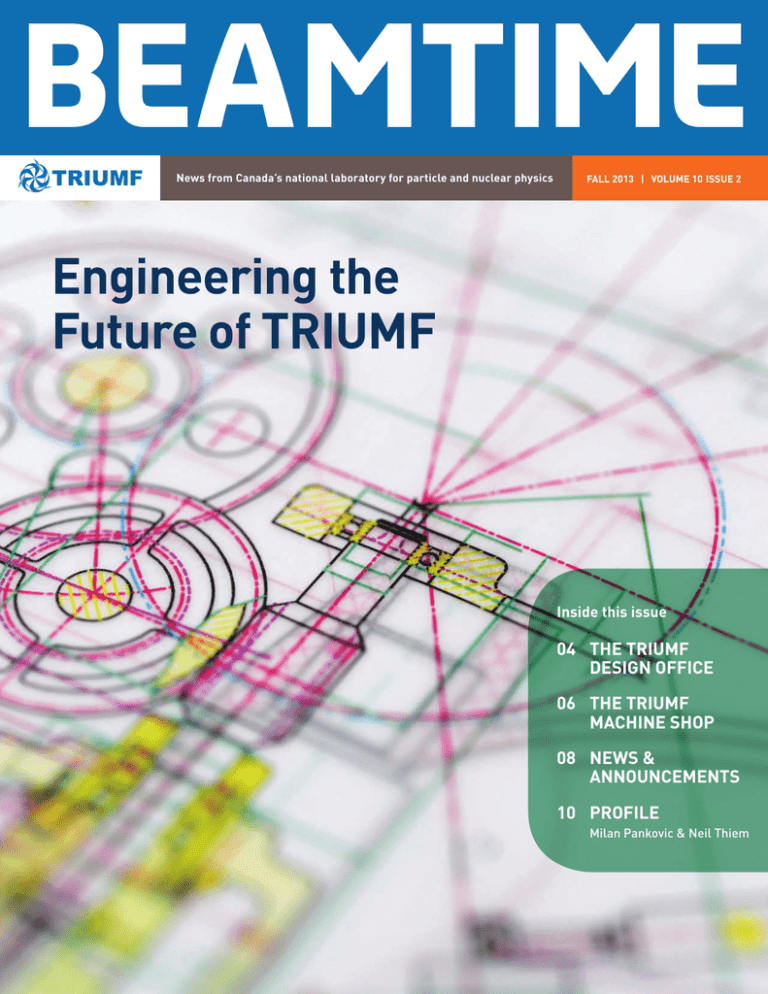
BEAMTIME
News from Canada’s national laboratory for particle and nuclear physics
FALL 2013 | VOLUME 10 ISSUE 2
Engineering the
Future of TRIUMF
Inside this issue
04 THE TRIUMF
DESIGN OFFICE
06 THE TRIUMF
MACHINE SHOP
08 NEWS &
ANNOUNCEMENTS
10 PROFILE
Milan Pankovic & Neil Thiem
fall
Editor:
Marcello Pavan
Production:
Serengeti Design Group
Beamtime is available online at:
http://www.triumf.ca/home/
for-media/publicationsgallery/
newsletter
Inquiries or comments to:
newsletter@triumf.ca
© 2013 TRIUMF Beamtime
All Rights Reserved
TRIUMF
4004 Wesbrook Mall
Vancouver, BC V6T 2A3
Canada
+1 604 222 1047 telephone
+1 604 222 1074 fax
www.triumf.ca
To obtain Beamtime by PDF, sign up
at http://lists.triumf.ca/mailman/listinfo/triumf-publications
TRIUMF is funded by a contribution
through the National Research Council
of Canada.
The province of British Columbia
provides capital funding for the
construction of buildings for the
TRIUMF Laboratory.
DIRECTOR’S VOICE
3
Jim Hanlon | Interim CEO/CAO, TRIUMF
“The only constant is change.”
– Heraclitus
If there is one thing that is always true at TRIUMF, it’s that
the lab is changing.
And so we are encountering a change in the face of our leadership. After a successful
six-year tenure as Director, Nigel Lockyer has moved to the U.S. Fermi National
Accelerator Laboratory to lead their efforts to uncover the secrets of the Higgs boson
and neutrinos to reveal the hidden nature of energy, space, and time. We are proud to
see Nigel tackle this challenge, and we are sad to see him go.
The TRIUMF Board of Management has appointed an interim Leadership team chaired
by a Chief Executive Officer / Chief Administrative Officer while the international search
for TRIUMF’s next director is underway. I am honoured to serve in this interim role and
committed to keeping TRIUMF on track to fulfilling its commitments and securing
a new future with the Five-Year Plan 2015–2020.
This issue of Beamtime addresses a different kind of change, namely the remarkable
transformation of our design and fabrication facilities over the past decade. As Canada’s
national laboratory for particle and nuclear physics, TRIUMF is associated with leading
scientific discovery in these areas, and as Canada’s national accelerator laboratory, we
are recognized for our prowess in the fundamental research and technology that power
those discoveries. Yet, this high-profile science depends on teams of top-level craftsmen,
technicians, and engineers working diligently behind the scenes to make this ever more
technologically-sophisticated science possible.
TRIUMF’s Design Office and Machine Shop truly have been able to evolve to meet the
steadily-increasing challenge of turning the visions of inspired physicists into reality.
This issue explores and celebrates these core capabilities that make TRIUMF the
incredible resource for Canada that it is. I invite you to peruse these pages and
imagine for yourself how you would turn your experimental challenge into reality,
be it mechanical, electrical, computational, cryogenic … whatever! Don’t worry—
if you cannot figure it out, TRIUMF can.
“
[TRIUMF’s] science
depends on … toplevel craftsmen,
technicians, and
engineers
”
engineerin
4
The TRIUMF Design Office
From Hand Sketching to Immersive Virtual Reality
by Daniel Rowbotham, Head of Mechanical Design
The first computer-aided design systems were a transformative, but evolutionary, advance
over the preceding age-old pen-and-paper techniques. Modern 3D-based systems have
shifted the mechanical design paradigm, with new advances promising even more radical
capabilities ahead. The TRIUMF Design Office was — and will be — there every step of
the way.
In 2006, [...] the TRIUMF Design
Office began a paradigm shift
the creation, duplication and revision of
electronic drawings at a significantly faster
rate. However, though AutoCAD™ could
display a design, the geometry did not
hold design information beyond the actual
lines and circles required for the creation
of the object (see Figure 2). Furthermore,
the two-dimensional (2D) drawings
produced by AutoCad™ were more of an
indirect representation of the end product,
providing opportunity for misinterpretation
and error. Hand sketching a design during
the ideation stage was still an integral tool
of the designer.
Fig. 1: (ca. 1985) An assembly of a scattering chamber, hand drawn on vellum paper
by Roland Kokke, a 38-year veteran of the TRIUMF Design Office.
Between 1970 and 1985 TRIUMF’s Design
Office employed two types of engineering
graphical representation, perspective
drawing and orthographic projection,
which were hand drawn with pencil or
ink onto either Mylar film or vellum.
The designer of this era was required
to think like an engineer but also like
an artist, with the skills and patience
to produce intricate drawings taking
considerable time and effort (see Figure
1). Circa 1985, the TRIUMF Design Office
introduced computer-aided design (CAD),
with the use of AutoCAD™, an application
that also worked in two dimensions but
significantly increased design productivity
and eventually emulated our paper
drawing process. AutoCad™ facilitated
In 2006, with the advancements in
computer- and graphics-processing
speeds, the TRIUMF Design Office began
a paradigm shift, transitioning from 2D
to 3D design by introducing a parametric
feature-based modelling approach
utilizing SolidWorks™. This tool provided
unparalleled advantages: realistic
visualization, design intent, continuity of
effort, and unambiguous communication.
Its capacity in graphical representation
proved much more powerful, both as a
thinking and communication tool, and it
has since become our primary tool for
defining geometry during the mechanical
design process (see Figure 3).
ng
5
Fig. 2: (ca. 2000) An AutoCad™ illustration of a coupling loop deployment system,
created by Tim Emmens, a 34-year veteran of the TRIUMF Design Office.
drawing lifecycle. This feature reduces
drawing-creation and revision-process
times, increasing the speed, accuracy, and
consistency of our output. At the end of the
design cycle, the model and drawings exist
as a fully-defined and controlled digital
package that contains enough data to be
directly imported into the TRIUMF Machine
Shop’s computer-aided manufacturing
machines, which can directly and
efficiently produce the end product. (See
also accompanying article this issue).
Fig. 3: (ca. 2003) A virtual prototype of the ARIEL
Injector Cryomodule created in SolidWorks™ in a
collaborative effort by the TRIUMF Design Office.
For the modern designer, the future
is even more exciting.
It is now possible to incorporate the
intellectual arrangements of features
on parts, and parts within assemblies,
and then validate intent through
virtual prototyping. Drawings are now
automatically generated from the model
and remain linked to it throughout the
For the modern designer, the future is
even more exciting. Advancements in
modeling techniques will allow designers
to interact directly with the geometry of
their models without having to edit the
interim model stages as one would in
parametric modeling. This enhancement
will enable designers to create very
complex geometries utilizing a much
simpler and faster method, thereby
allowing a greater selection of design
options to engineers and scientists.
The technology behind augmented reality
will permit designers to project 3D models
into real-world environments to exhibit
proper scaling and demonstrate function
to a broader audience. The development
of leap motion, a technology that tracks
Fig. 4: (2013) A virtual-tool path performed
on a Design Office model with the use of
MasterCAM™, the Machine Shop’s computeraided manufacturing application that directly
imports SolidWorks™ models.
hand movements within 100th of a
millimetre at 200 frames per second, will
enable designers to create and manipulate
3D models using hand gestures. This
technology is the precursor to immersive
virtual reality, which promises the ability
to manipulate geometric shapes using
ocular headsets and haptic gloves. And
with further advancements in additive
manufacturing, aka 3D printing, the
designers of the imminent future will be
able to move their geometric models easily
into reality, producing prototypes with little
or no machining expertise required.
The TRIUMF Design Office looks forward
to embracing yet another revolutionary
paradigm shift!
The TRIUMF Design Office consists of
a diverse group of ten highly innovative
mechanical designers each bringing their
own unique abilities in providing the nexus
for the creation of successful design
outputs that support the development of
experimental equipment, instrumentation,
and systems associated with TRIUMF’s
program of research.
fabrication
6
The TRIUMF Machine Shop
Machine Shop Tools up for the Challenges
by Ivor O. Yhap, Machine Shop Supervisor
TRIUMF’S success in developing new components,
detectors, and experimental equipment depends not
only on its scientists and engineers but also on the
skill sets of the CNC (computer numerically controlled)
machinists/programmers, manual machinists, and
welders/fabricators.
This group of skilled craftsmen are
continually faced with new challenges
with regards to complex designs, exotic
materials, and very strict timelines.
Over the past ten years the machine shop
has gone through a major restructuring
and modernization process. In many ways
the changes have mirrored those in the
Design Office (see accompanying article
in this issue), where manually-operated
tools have given way to computercontrolled machines, with the concomitant
improvement of speed, precision, and
repeatability of machined components
of ever-increasing complexity. In fact,
the new tools can produce fantasticallycomplicated objects considered sheer
fantasy a short while ago. (See Figure 2)
As a result, TRIUMF scientists, engineers,
and designers now have considerably
more flexibility and can deploy much more
creativity when designing components
for their projects.
The machine shop has gone through
a major [...] modernization process.
Fig. 1: Machinist Clayton Handley supervising one of TRIUMF’s latest CNC machining centres.
An example of his handiwork is shown in the foreground.
The Machine Shop has upgraded its
standard array of manually-controlled
machines (lathes, mills, etc) with seven
CNC machining centres, one water-jet
cutting machine and one electronbeam welder. The computer-controlled
machines employ the Mastercam™
software environment for tool control.
This enables the machines to import
SolidWorks™ design files directly from
the TRIUMF Design Office, increasing
efficiency and eliminating a source where
n
7
“
These facilities are operated and supported
by a top-notch team
”
Fig. 2: An example of the complex components
crafted from a single block of metal by the CNC
machine centres.
operator error might occur. Overall shop
efficiency gained a major improvement
with the recent acquisition of a waterjet cutting machine, which has freed up
machining time by eliminating the need to
machine large profiles on plates and sheet
metal. These facilities are operated and
supported by a top-notch team consisting
of one supervisor, one foreman, one
stand-in foreman, thirteen machinists,
two welders/fabricators, one water-jet
operator, and one assistant material
handler (see Figure 3). In instances where
the Machine Shop is oversubscribed or
underequipped for a particular job or
time-sensitive large production runs,
work is contracted out to local industries
as part of TRIUMF’s mandate to support
the local economy.
The (CNC) machines [...] import
[...] design files directly from the
TRIUMF Design Office.
One area that highlights the requirements
faced by the Machine Shop is producing
Fig. 3: Members of the TRIUMF Machine Shop pose proudly among the tools of their trades.
components for high-vacuum applications.
The TRIUMF accelerators, beam lines,
and many experimental facilities operate
at very high vacuum — down to conditions
outside the space station! — so highly
specialized welding and fabrication
techniques are critical to success.
These high-vacuum components,
including diagnostic boxes and bellows
assemblies, also must be leak tested for
quality assurance. Fusion welding by our
electron-beam welder is performed in
vacuum and is applicable for both similar
and dissimilar metals. Electron-beam
welding (EBW) is also used to produce
targets for isotope production, meson
production, and ISAC radioactive-ion
beam production. Typically these targets
require exotic materials such as tantalum,
molybdenum, or very thin foils where EBW
is the only assembly technique possible.
In these heady days of large-scale facility
developments such as ARIEL, users
of the machine shop are increasingly
appreciative of the collective skill sets
of our craftsmen and becoming more
proactive with regards to consulting about
design, machining, and fabrication issues.
And with the convergence of leadingedge fabrication and design expertise at
TRIUMF, one can expect the Machine Shop
to be a backbone of lab operations well
into the future.
news &
announcem
8
News & Announcements
ARIEL Building Completed
by Melissa Baluk
facilities and the beam lines from the
new superconducting electron linear
accelerator and the existing proton
cyclotron. Plans are for the first beam
from the new electron accelerator to
be transported to the service building
by fall of this year.
Engineering TRIUMF’s Future
by Tim Meyer
The construction of TRIUMF’s flagship
Advanced Rare IsotopEs Lab (ARIEL)
reached an important milestone with
the completion of the civil construction,
including the new services building.
ARIEL is a major addition to the TRIUMF
complex that will greatly expand
the scientific potential of the ISAC
radioactive-ion-beam facility. The finish
line came into view with the dismantling
of the crane tower in early May 2013, and
the finishing touches were applied without
fanfare by late summer.
Nearly 6000 cubic metres of concrete,
or about 600 truckloads and 100,000
hours of labour, went into the six-storey
structure. With the heavy lifting (literally)
completed, work on preparing the building
for beam lines began in earnest. Inside
its massive caverns, ARIEL will house
the radioactive ion-beam production
TRIUMF employs roughly 500 staff, of
which about 50 are research scientists
who are the principal investigators for
the competitive, peer-reviewed research
conducted at the lab. But what about
the other 450 or so people? They are
the foundation enabling and supporting
TRIUMF’s world-class research. Worldclass research requires world-class
people, and TRIUMF’s collection of highlytrained technicians, engineers, and IT
talent is likely unmatched anywhere else
in the country.
TRIUMF was founded more than four
decades ago by Canadian universities
to design, build, operate, and maintain
infrastructure for research that no single
university could manage on its own.
The technical team that has blossomed
at TRIUMF is recognized as highly-valued
specialists in their areas, whose portfolio
of transferable skills has only increased in
the face of the unique technical challenges
posed by the lab. In recent years TRIUMF
has made a concerted effort to get more
and more of its engineers recognized with
the “Professional Engineer” (or P.Eng)
credential through the Association of
Professional Engineers and Geoscientists
of BC (APEGBC www.apeg.bc.ca).
TRIUMF now has approximately 20 P.Eng.
engineers on staff and about a halfdozen Engineers in Training (EIT). Several
secured their certification via professional
development at the lab, among them
recently Grant Minor, Bob Sidhu, and
Aurelia Laxdal, with Design Office leader
Dan Rowbotham formally recognized as a
Professional Engineering Manager. Such
an impressive group of highly-qualified
personnel will serve TRIUMF well as it
heads into the next phase of its research
life with the ARIEL project.
You can learn more about TRIUMF’s highlyskilled professionals by visiting the careerprofiles site at
http://www.triumf.ca/home/careers-attriumf/career-profiles
TRIUMF and VECC sign
cooperation agreement
by Ariane Madden
At a formal ceremony at TRIUMF on
August 8, directors Nigel Lockyer
(TRIUMF) and Dinesh Srivastava of the
Variable Energy Cyclotron Centre (VECC)
of Kolkata, India inked a new partnership
agreement valued at $10.4 million for the
advancement of isotopes and accelerators.
The agreement will see manpower
and resources exchanged between the
facilities to complete their respective
next-generation rare-isotope facilities —
ARIEL at TRIUMF and ANURIB at VECC.
Five years of collaborative research and
development beween TRIUMF and VECC
9
ments
In addition to TRIUMF, the team includes
experts at the BC Cancer Agency, the
Centre for Probe Development and
Commercialization, and the Lawson
Health Research Institute. The team’s
next milestones include engineering
optimization and regulatory approval,
which will pave the way to creating a
competitive proposal for diversifying the
Tc-99m supply chain with robust and costeffective cyclotron-based technology.
led to this new partnership framework,
which also involves a number of Canadian
companies. For example, PAVAC
Industries, Inc. of Richmond, BC will be
manufacturing the high-tech cryomodules
using technology transferred from TRIUMF
through AAPS, Inc., TRIUMF’s non-profit
commercialization partner. The ceremony
was attended by federal Minister of
National Revenue, Kerry-Lynne Findlay
and provincial International Trade Minister
Teresa Wat.
Initial research was supported by Canada’s
National Sciences and Engineering
Research Council and the Canadian
Institutes for Health Research through a
grant awarded via UBC led by François
Bénard (BCCA) and Tom Ruth (TRIUMF).
A native of Greece, Lia came to TRIUMF
in 2008 after serving as director of beam
physics at the Jefferson Laboratory in
Virginia. She has garnered respect and
admiration from experts in her field world
wide, and TRIUMF is proud to have her
as one of our own.
Calendar
Upcoming Important Events
(at TRIUMF unless otherwise stated)
Jan 13 & 14
MMS-EEC
Jan 24 & 25
SAP-EEC
Feb 14–16
WNPPC
Conference
Banff Centre, AB
Canadian Solution to MedicalIsotope Crisis Demonstrated
by Tim Meyer
With Canadian-developed tools and
technology, a national team led by
TRIUMF reached a crucial milestone
in June 2013 at the BC Cancer Agency
(BCCA) by demonstrating a viable
alternative for supplying key medical
isotopes to a metropolitan area. The team
used a medical cyclotron designed and
manufactured by Advanced Cyclotron
Systems, Inc. and outfitted with a
specially-designed target add-on (see
photo) to successfully produce enough
technetium-99m (Tc-99m) overnight to
supply an urban area the size of Vancouver.
This achievement eliminates the need for
nuclear reactors utilizing weapons-grade
uranium (which is the technology used
currently) to produce this key medical
isotope, and is a crucial step toward
meeting Canada’s isotope needs after
the NRU reactor at Chalk River, ON
ceases production in 2016.
For details see
http://www.triumf.ca/nrcan-isotopes
Merminga honoured with
Women in Science award
Mar 28
AAPS Board
of Directors
Meeting
Mar 31 & Apr 1
LSPEC
Apr 4
Board of
Management
Meeting
May 12 & 13
ACOT Meeting
by Ariane Madden
Dr. Lia Merminga, Head of TRIUMF’s
Accelerator Division at TRIUMF, was a
recipient of the 2013 Women In Science™
award for Community Leadership and
Excellence from the Minerva Foundation
for BC Women. The awards honour British
Columbian women who excel in their
scientific fields. The award recognized
Lia’s integrity, excellence, and vision
not only for TRIUMF, but also for the
entire field of accelerator-based physics
and technology.
TRIUMF Event Calendar
admin.triumf.ca/d2w-pub/eventscal/
display
profile
10
Milan Pankovic and Neil Thiem
Old-school Savvy and New-age Skills Crafting TRIUMF’s Future
by Gabriel Baron
Left: Milan Pankovic
Right: Neil Thiem
Operating behind the scenes, the TRIUMF Machine Shop
is critical to the continued successful operation of the
laboratory. And it takes master craftsmen like Machinist
Foreman Milan Pancovic and fabrication welder Neil Thiem
to meet the technical challenges posed by TRIUMF’s
scientists and engineers.
Milan is the longest-serving member
in the Machine Shop with over 35 years
of service. When he started, TRIUMF
used machinists like Milan to operate
manual lathes and milling machines,
often taking many weeks to fabricate
a single component. Since then, Milan
has seen the Machine Shop evolve as
TRIUMF quadrupled in size, with recent
investments in new machining technology
creating a much more productive facility
utilizing CNC (Computerized Numerical
Control) tools capable of fabricating
components in just a day that once
required weeks (to within 5/10000th
of an inch precision!). The roles of the
shop’s master machinists have changed
from manually operating the tools to
entering design parameters into the
CNC computer. The machinists receive
a blueprint from the Design Office,
formulate a fabrication plan and then input
the dozens of variables required for the
machine to do its job correctly, ranging
from material composition, to tooling
parameters, to component location of up
to 5 different axes. After the fabrication
program is verified, the machine runs and
the machinist monitors the work as the
component is created. Years of experience
have given Milan a deep understanding of
the wide variety of materials available and
how best to machine them.
The Machine Shop is staffed not only
with savvy veterans like Milan, but also
talented newcomers who bring new-age
skills to the team. Neil Thiem is one of
the newest members who joined TRIUMF
two years ago with 20 years worth of
welding and fabrication experience.
He previously worked in Afghanistan
with the Canadian Armed Forces, helping
to fix equipment requiring heavy-duty
repair or fabrication, from trucks to tanks
and even drones. Neil’s improvisational
experience on complicated high-tech
machinery in the field is very well matched
to TRIUMF’s problem-solving research
and development nature. When not busy
welding beam lines, he is solving unique
problems faced by staff scientists, like
fabricating a component able to withstand
10,000 lbs. of pressure made of titanium
on one side and steel on the other.
Through experimentation Neil found a
novel way to bind these metals together
with silver solder. The end result? Happy
scientists and a successful experiment.
All the old-school veterans and new-age
talent in the Machine Shop are at the top
of their game, and more than equal to
the unique challenges thrown at them by
the lab. Master craftsmen like Milan and
Neil work diligently to ensure the ongoing
success of the lab’s scientific program,
and TRIUMF is lucky to have them all.
11
Photo: CUPC 2013
OUTREACH
TRIUMF Symposium graduates excel at CUPC: Undergraduate students
Sebastien Rettie, Ben Davis-Purcell, and Chelsea Dunning (R-L) received
the top three honours, respectively, for their particle/nuclear physics
presentations at the annual Canadian Undergraduate Physics Conference,
hosted by McMaster University in October.
TRIUMF goes into the Community: Staff scientist (and local resident)
Colin Morton and graduate student Ewan Hill interact with guests visiting
the TRIUMF booth at the nearby Wesbrook Village Festival on Saturday
September 7.
Unveiling the Universe public lecture: Dr. Paul Schaffer, Head of TRIUMF’s
Nuclear Medicine Division, presented his lecture November 27 on “Medicine
Accelerated: Canada’s Role in the Medical Isotope Revolution” to an
appreciative crowd at the TELUS World of Science in Vancouver.
TRISEP: The inaugural Tri-Institute Summer School on Elementary Particles
(TRISEP) took place at TRIUMF July 1-12, 2013, where international graduate
students and post-doctoral fellows heard from leading experts on cuttingedge particle physics. See www.trisep.ca for more information.
The Community comes to TRIUMF: Gusting winds of nearly 80 km/h and
torrential rain weren’t enough to stop nearly 1,200 people from attending
TRIUMF’s 2013 Open House on Saturday September 28, which celebrated
the 100th anniversary of the discovery of isotopes.
Photo: Nicole Marie Bienvenu
High School Fellows: High School Fellowship students (from left) Keiler Totz,
Ben Friedman, and Lloyd James adjacent their supervisors Stefan Zeisler,
Ruediger Picker, and Fabrice Retiere, with TRIUMF Director Nigel Lockyer
(centre right). The Fellows were chosen from among the top science students
in British Columbia, and took part in a six-week work term at TRIUMF,
finishing in early August with a talk at the Summer Symposium.
THE ART OF PHYSICS
Stargate
The DESCANT neutron detector array
Seen head on without the detectors that will soon populate it, the frame of the DESCANT neutron array is
eerily reminiscent of the space portal visualized in the television series “Stargate”. DESCANT, designed
by the TRIUMF Design Office, will work in tandem with both the TIGRESS and GRIFFIN gamma-ray
spectrometers to detect neutrons emanating from nuclear reactions involving radioactive isotopes.
TRIUMFLab
www.triumf.ca

